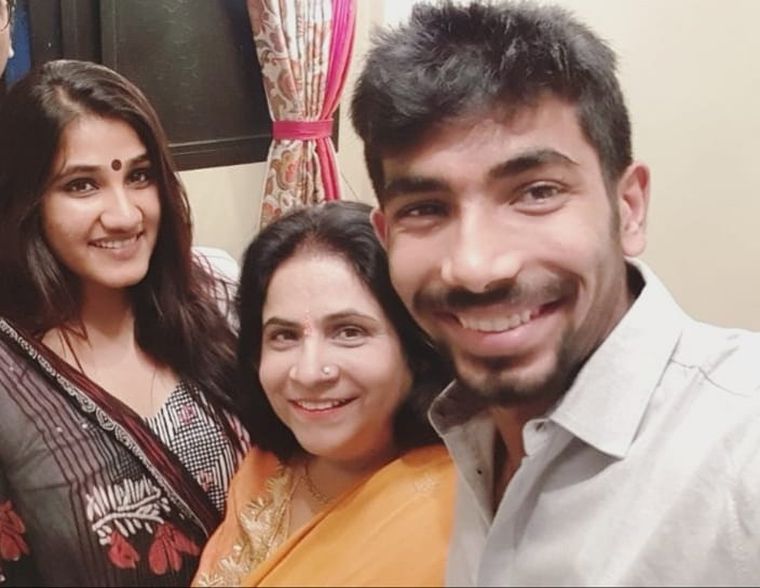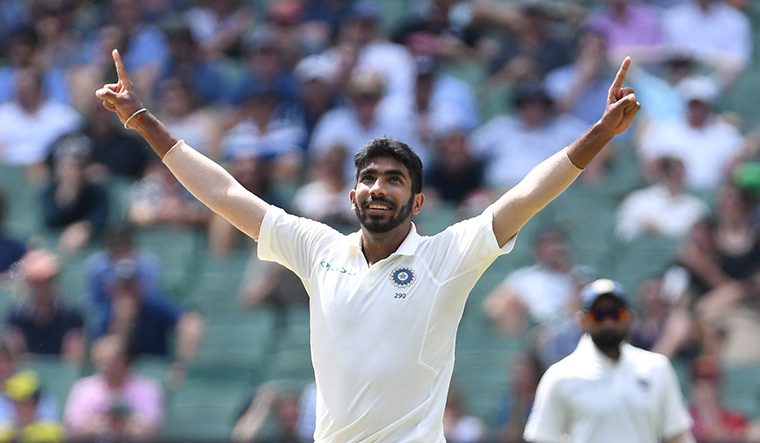In the mid-2000s, the Hindi soap opera Jassi Jaissi Koi Nahin took India by storm. It was about a capable young woman, with an unconventional look, who lands a job at a leading fashion agency. Though initially considered an outsider to the world of glitz, she breaks through with her determination and diligence. The show, a breath of fresh air on Hindi television, at least initially, ran for more than three years and amassed a huge following.
More than a decade later, another Jassi—Jasprit Bumrah—has become a household name. The 25-year-old pacer ran through the Australians in Melbourne, and has already pocketed quite a few records. In just one year of playing Tests, he has taken 48 wickets, and has left many a batsman sleepless.
Hopefully, his stay will last much longer than the onscreen Jassi.
The name aside, unconventionality connects the two. Jasprit’s bowling action—his non-bowling arm stays rigid, and does not move down as the other one goes up—is quite unorthodox. But Jassi, as friends and teammates call him, has made his action an asset. And, his consistent performances have put him on the list of dependable players along with captain Virat Kohli and Cheteshwar Pujara.
Though he had done quite well in South Africa and England in early 2018, it was his nine-wicket haul in the Boxing Day Test that propelled him to greater heights. The captain himself called him the best bowler in the world, and several experts had his name on their lips.
 While a young Jasprit toiled on the field, his mother, Daljit, kept the home running. After the death of her husband, Jasbir, she brought up Jasprit and his sister Juhika on her own. “We were rich. Then, we saw difficult times,” says Daljit. “Jasprit has seen both, and knows that nothing is permanent.” | Picture Courtesy: Jasprit Bumrah, Instagram Page
While a young Jasprit toiled on the field, his mother, Daljit, kept the home running. After the death of her husband, Jasbir, she brought up Jasprit and his sister Juhika on her own. “We were rich. Then, we saw difficult times,” says Daljit. “Jasprit has seen both, and knows that nothing is permanent.” | Picture Courtesy: Jasprit Bumrah, Instagram Page
Though it may seem like it, this was no overnight journey. Jasprit started playing serious cricket in his early teens at Nirman High School in Ahmedabad. His mother, Daljit, also worked there, and is currently principal of the pre-primary section. Kishore Trivedi and Ketul Purohit, two of his early coaches, spotted his talent from the get-go. “His only passion was cricket and bowling was a God-given gift,” says Purohit. He was different from the others in the lot; he had raw pace and an unusual action. Purohit remembers how batsmen would underestimate Jasprit because of his short run-up. “They could not believe that he generated such speed with a short run-up,” he says. “And, if they started adjusting to that, then it was difficult to judge his natural inswing.”
While a young Jasprit toiled on the field, his mother, Daljit, kept the home running. After the death of her husband, Jasbir, she brought up Jasprit and his sister Juhika all on her own. Jasprit was only seven when his father, who owned a chemical business, died following a brief illness.
Perhaps cricket was a welcome distraction for the child. It was when Jasprit was in class six that Daljit realised the boy’s love for the game. He would not play any other sport, remembers the mother. “He would play at home, in the society,” she says. “He would know the names of all the cricketers. He would watch only cricket on television, and all his posters were of cricketers.”
Daljit did not dissuade him, but she set one condition. “I told him that his studies were important and he should have a backup plan,” she says. He was an average student, she adds, but would always complete his homework before going for practice, twice a day. By the time Jasprit reached class eight, his talent became evident. “He would go for selection trials and matches, and would be selected everywhere. This made me realise that there was something in him,” she says.
Jasprit’s school principal, Leena Sudan, remembers him as a sober, well-behaved boy. “He was content with what he was doing,” she says. “He was not a [top] ranker, but was a little above average.” He was reserved, and would not go out of his way to talk to someone. “Such was his nature that nobody ever complained about him. He was patient and had endurance,” she says, adding that this endurance took him to the next level.
He was a natural, say his coaches. He bowled fast, and learnt fast. A patient listener, he also worked hard on his fielding. He knew he would have to do so to get into the Indian side one day. Says Hitesh Majmudar, coach of the Gujarat Ranji team: “Earlier, Bumrah was not good at fielding. But now you can trust that he will never misfield or drop a catch.”
Vijay Patel, another coach of the Gujarat team, says Jasprit was spotted after there were reports of a teenager bowling fast at the school level. That too with an odd action. The district board of the Gujarat Cricket Association brought him on board, and he impressed in his first year at the Under-19 level. Apparently, some people wanted him to play the Ranji Trophy, but he was held back; he played the Under-23 level first. Patel still remembers how Jasprit was the surprise bowler in Gujarat’s first match against Vidarbha.
The turning point, however, came when the Mumbai Indians picked him, all of 19, to play the Indian Premier League. “Bumrah played everything else later,” says Majmudar. “Mumbai Indians coach John Wright was in Ahmedabad to watch a match. He, and [former India bowler] Abey Kuruvilla, were impressed. Both Bumrah and Axar Patel were picked.”
A few years later, Jasprit has proven himself on the biggest stage. “He is not playing for India without doing anything,” says Majmudar.
India’s spearhead, however, has always been down to earth. Probably because of the early hardships following his father’s death. “We were rich,” says Daljit. “Thereafter, we saw difficult times. Jasprit has seen both, and knows that nothing is permanent.”
During those years of adversity, some close friends became the Bumrahs’ support system. One of Daljit’s friends, in fact, became more like a mother to Juhika, as her mother was busy with Jasprit.
“The mother has faced hard times,” says Bhupendrasinh Bhusari, a close family friend. Bhusari’s wife Avneet has been friends with Daljit for more than two decades; the two also work together.
Bhusari describes Jasprit as good-natured, and credits his hard work for his rapid rise in world cricket. Daljit, too, says Jasprit would never shy away from hard work. “At times, when he used to come late from practice, I would ask him the reason for the delay,” she says. “He would tell me that he was with the coach; talking [about the game].”
The mother’s only complaint is that Jasprit has not been able to finish his education. He has completed one year of his BCom. “He has tried writing the examinations,” says Daljit. “But every time there is an examination, he has his matches.”
What about plans of marriage? Not for another three to four years, she says. “He is 25 and says that he wants to concentrate on cricket.”
A Punjabi by birth, Jasprit is not as flamboyant as his brethren. However, he does share their love for food. “He loves to eat chicken biryani and kaali dal,” says Daljit. And, he also loves listening to Punjabi songs.
Another Punjabi trait is the aggression, at least on-field. Off it, say his coaches, he is quite shy. “He does not mix easily with others,” says Majmudar. “He has been close to [Gujarat cricketers] Manprit Juneja and Axar Patel. During his tours, he shared a room with Juneja,” says Majmudar.
Juneja, who has played alongside Jasprit many a time, says he never doubted the bowler’s potential. “He had something rare in him, and I used to often tell him that he would make it big,” says Juneja. “Some players are good, but not hard workers, and some players are hard workers, but not good. Bumrah was both.”
The high praise, however, has not gone to Jasprit’s head. “Nothing will change in him,” says Juneja. “Nothing can change. He cherishes having a few best friends, rather than having a lot of friends.”
In his off time, Jasprit still talks to his Ranji coaches about how to bowl overseas, and returns to the Gujarat College Ground for practice, asking the groundsman to prepare the nets for him.
And, even when he phoned home after the superb spell in Melbourne, Jasprit was calm. “When I spoke to him and asked him how he felt, he told me he felt the same as the day before,” says Daljit. He does not set a target for himself ahead of each game, and just wants to give it his best, she adds.
Priyank Panchal, Jasprit’s Ranji captain, says it is the combination of his energy and the will to succeed that has taken Jasprit this far. “Bumrah is knowledgeable in terms of training, diet and recovery,” he says. “And now when I see him, he is a changed person.”
The coaches also praise him for his discipline, which is imperative for a long career. As Jasprit would know, pace bowlers’ careers are shortened by injuries. Perhaps that is why, say the coaches, he has worked even harder on his fitness, with special focus on his shoulders and lower body. He dutifully follows the BCCI’s fitness regime, even during the off-season. The board’s player-rotation policy has also helped, says Patel. In fact, such is Jasprit’s value that, at times, he is not even allowed to play domestic cricket.
A major turning point in the youngster’s career, in hindsight, was the coaches’ decision not to mess with his action. “Initially, I tried to change his action a bit, but realised that the pace fell by 50 per cent,” recalls Purohit. “So, we did not do anything further.”
Says Patel: “The action is natural and there is no way it can or should be changed. It was not even changed at the MRF Pace Foundation, where he was trained. If the action is changed, he will lose rhythm and touch.”
The coaches say Bumrah has become mature enough to fix his bowling himself, if anything goes wrong.
Bumrah’s exploits have won him fans throughout the country, including in his own alma mater. Says 11-year-old Garvit Vadhera: “I like his bowling action, especially the angle at which he bowls. We try his action in the nets.”
Recently, the video of a Pakistani child copying Bumrah’s action to a T went viral. That an Indian bowler is inspiring children in Pakistan, a country known for legends such as Imran Khan and Wasim Akram, is a pleasant turn of events. And perhaps one that bodes well for cricket everywhere.


